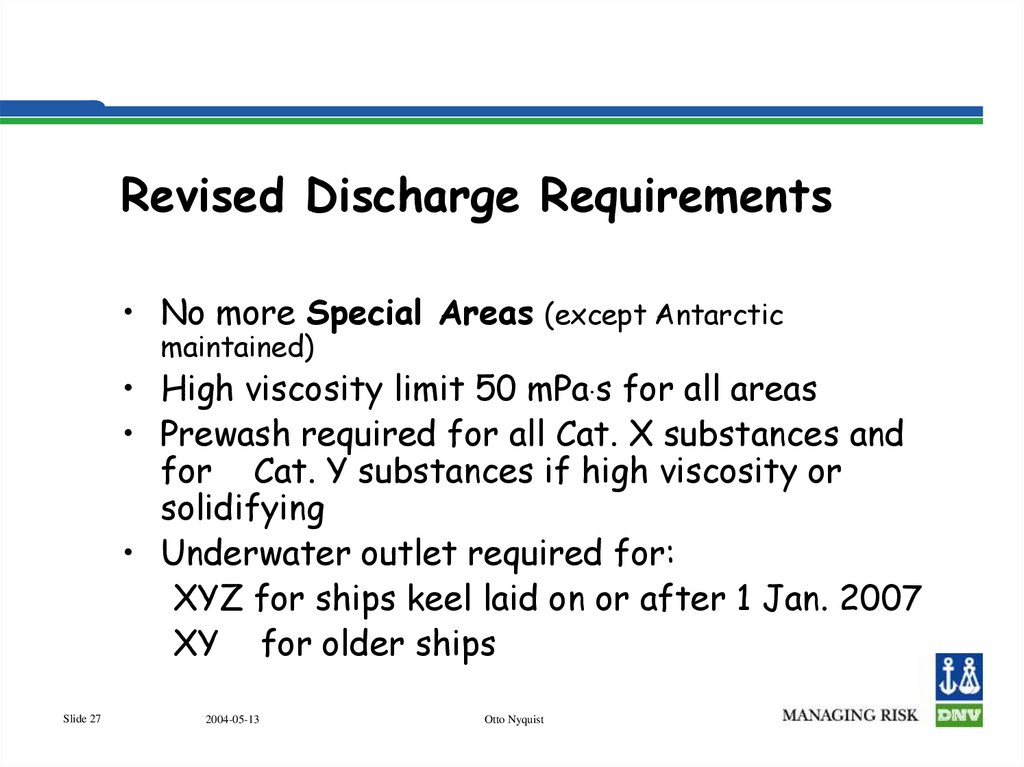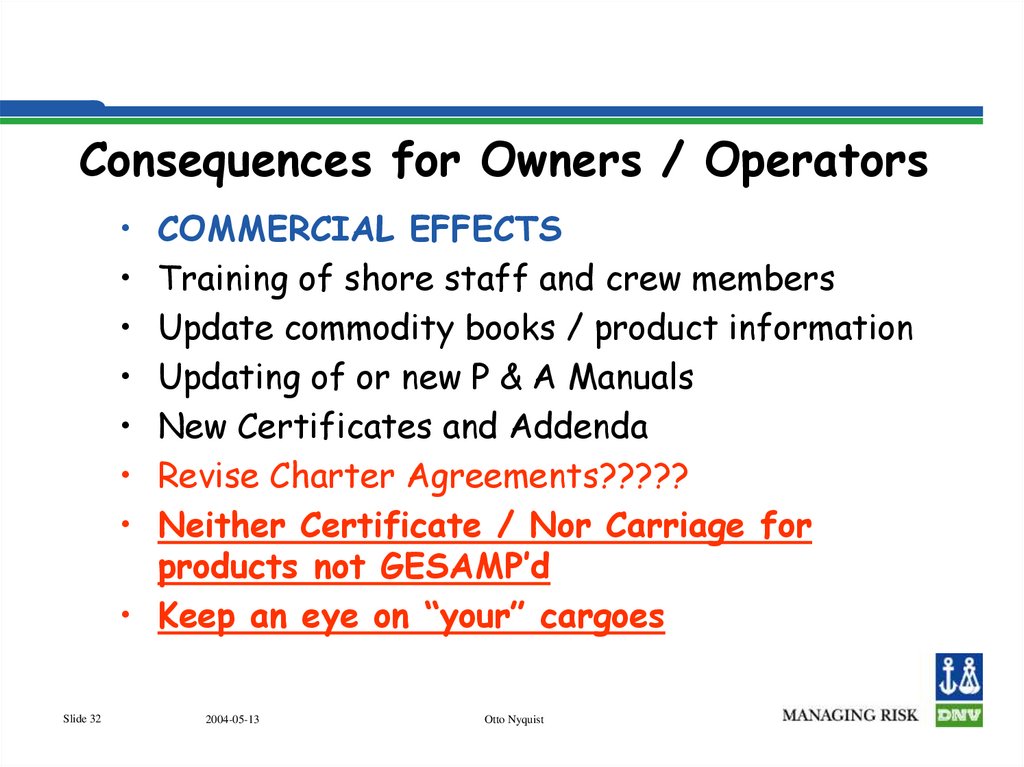Similar presentations:
Chemical Tanker Rules
1.
Slide 12004-05-13
Otto Nyquist
2. Cargo Handling, Piping Systems & MARPOL Otto Nyquist, Senior Principal Surveyor
Cargo Handling, Piping Systems & MARPOLOtto Nyquist, Senior Principal Surveyor
• Oil and Chemical Carriers
Arrangement and Piping:
– Approval of new-buildings for Oil and Chemical
tankers.
– Support and Issuance of Certificates and cargo lists for
new and existing ships.
– Representative in IMO BLG / ESPH WG
– 4-5 persons.
3. Chemical Tankers IBC Code, SOLAS & MARPOL
Chemical TankersIBC Code, SOLAS & MARPOL
Class Rules
SOLAS 74/ 78
MARPOL 73/ 78
I II III IV V VI
Chapter VII
IBC
IOPP
NLS
COF
2004-05-13
Otto
NyquistMANAGING
4.
IBC CodeApplication
All Ships carrying liquid cargoes other than oil,
having safety hazards (greater than or additional to those of oil)
and / or are of pollution category A, B or C
N.A. for petroleum or similar products
Relevant products are listed in chapter 17
Products to which the IBC Code does not
apply, are listed in Chapter 18
New products to be evaluated by flag state or
port state before carriage
Liquids having vapour pressure≤ 2,8 bar at
37,8 oC
2004-05-13
Otto
NyquistMANAGING
5.
Ship survival capability & location of cargo tanksShip type 1
Ship type 2
Ship type 3
DISTANCE NOWHERE
LESS THEN 760 MM
Tanker for Chemicals (ST 2) and Oil,
DWT > 5000
2004-05-13
Otto
NyquistMANAGING
6.
Cargo types/ Rules & RegulationsSafety
Hazards
S&P
Hazards
Pollution
Hazards
Poll.
Haz.
Poll.
Haz.
Cat. A, B, C
Cat. D,
FP<60
Cat. D,
FP>60
IBC cargoes
(Ch. 17 IBC)
No
Poll.
Hazard
No
Poll.
Hazard
FP<60
FP>60
NON- IBC cargoes
(Ch. 18 IBC)
-
SOLAS
-
(Tanker)
Certificate of Fitness
SOLAS
-
(Tanker)
NLS Certificate
-
(If not included in COF)
Acetonitrile
Methyl
formate
Phosphoric
acid
2004-05-13
Benzene
Creosote
Phenol
Sulphuric acid
Diphenyl ether
Toluene
White spirit
Methyl
alcohol
Animal oil
Vegetable oil
Ethyl alcohol
Molasses
Glycerin
Otto
NyquistMANAGING
7. Oil like substances
Oil like substances of Category C or D in MARPOL
Annex II Reg. 14 may alternatively be carried on Oil
tankers, when:
–
–
–
2004-05-13
Ship complies with Annex I as product
carriers,
the Oil content meter is approved for the
products and they are included in IOPP
Certificate,
for Category C product ship complies with
Ship type type 3 damage stability
requirements.
Otto
NyquistMANAGING
8.
CARGO SPECTRUM FOR CHEMICAL TANKERSAND OIL PRODUCTS TANKERS
Chemical Tanker Domain
Oil Product Tanker Domain
Alcohols
MTBE
Veg. Oils
Molasses
UAN
……
……
2004-05-13
Pentane
Toluene
Xylene
……
……
……
……
Caustic
soda
……
……
Otto
NyquistMANAGING
9. Oil & Chemical tankers in DNV
Oil & Chemical tankers in DNV• Below 70000 DWT:
–
–
–
–
–
–
2004-05-13
Tanker
Tanker
Tanker
Tanker
Tanker
Tanker
for
for
for
for
for
for
Vegetable oil & Edible oil:
Methanol:
Oil and Caustic Soda:
Oil Products:
Oil:
Oil and Chemicals:
12
1
19
72
447
283
Otto
NyquistMANAGING
10. ANALYSIS OF CARGO PARCELS BY PRODUCT TYPE IN CHEMICAL TANKERS
Acid Inorganic
Acid Organic
Animal Oils and Fats
Caustic
Petrochemicals
Coconut Oil
Clean Petroleum Products
Dirty Petroleum Products
Drying Oils
Fish Oils
2004-05-13
6.2%
0.7%
4.8%
11.6%
35.1%
7.5%
10.9%
0.1%
0.6%
0.9%
Liquid Fertilizers
Lubricating Oils & Additives
Mineral Spirits
Molasses
Other Specially Chemicals
Palm Kernal Oil
Palm Oils
Vegetable Oils
Waxes
0.7%
4.5%
3.5%
1.1%
0.6%
1.5%
4.5%
4.9%
0.3%
Otto
NyquistMANAGING
11.
RevisedMARPOL Annex II and
Chem Code
AND THE CONSEQUENCES
Slide 11
2004-05-13
Otto Nyquist
12. To set the scene
MARPOL 73/78 has 6 Annexes• Annex I
• Annex II
Slide 12
Annex
Annex
Annex
Annex
III
IV
V
VI
2004-05-13
Oil (cargo and engine room)
NLS (i.e. all other liquids
carried in bulk
......
......
......
...... (enters into force 19 May 2005)
Otto Nyquist
13. To set the scene
Current Annex II has 5 AppendixesAppendix
Appendix
Appendix
Appendix
Appendix
I
II
III
IV
V
Guidelines
Noxious Liquids A – B – C – D
Other (non-noxious) substances
Cargo Record Book
NLS Certificate Form
5 Category system = A - B – C – D - III
Slide 13
2004-05-13
Otto Nyquist
14. Purpose of the revision
Slide 14
Editorial improvements
Adaptation to new GESAMP procedure
Reduction of number of categories
Simplification of operational requirements
Fewer non-regulated substances
Reduction of legal discharges
Keeping up with technical development
2004-05-13
Otto Nyquist
15. Time schedule (expected)
• Approved for circulation:MEPC 51 (April 2004) (done)
• Formal adoption:
MEPC 52 (15 October
2004) (done)
• Formal adoption of IBC Code by MSC 79:
December 2004
• Tacit acceptance confirmed:
1 July 2006
• In force for all ships:
1 January 2007
Slide 15
2004-05-13
Otto Nyquist
16. Nature of revised requirements: Operational requirements for the individual substances
Therefore:• Applicable to all (both new and existing) ships
• Applicable from the set date
• Replaces current requirements (which remain in
force until the set date)
Slide 16
2004-05-13
Otto Nyquist
17. Editorial updating
• Outdated text deleted• Requirements of P & A Standards incorporated
in Annex II regulations
• Requirements for P & A Manual clarified
• Stripping requirements clarified / formalised
• Simplification of requirements and procedures
• “Oil-Like” does no longer exist
Slide 17
2004-05-13
Otto Nyquist
18. Basis for assigning Pollution Categories - GHS (Globally Harmonized System) for evaluation of Chemicals: - New GESAMP Hazard
Evaluation Procedure and Profile:- Change from 5 to 4 Categories:
- New Guidelines for assigning Pollution Categories:
Slide 18
Most Cat. A
become
Cat. X
Most Cat. B + Cat. C
become
Cat. Y
Most Cat. D + App. III become
Cat. Z
Some few App. III
become
OS
Almost all Ch. 17 or Ch. 18 products will require
Chem Code CoF or NLS Certificate
2004-05-13
Otto Nyquist
19. Guidelines for assigning Pollution Categories
RuleA1
A2
≥4
3
4
D3
Cat
NR
≥4
4
NR
CMRTNI
4
6
3
7
2
≥4
X
NR
Y
Not 0
≥1
9
10
Fp, F or S (if
not inorganic)
11
Slide 19
E2
4
5
8
B2
≥5
1
2
B1
CMRTNI
12
Any product not meeting the criteria of rules 1 to 11 and 13
Z
13
All products identified as: ≤2 in column A1; R in column A2; blank in column D3; not Fp,
F or S (if not inorganic) in column E2; and 0 (zero) in all other columns of the GESAMP
Hazard Profile
OS
2004-05-13
Otto Nyquist
20. Basis for assigning Ship Types - GHS (Globally Harmonized System) for evaluation of Chemicals: - New GESAMP Hazard Evaluation
Procedure and Profile:- New Criteria for assigning Ship Type for Pollution reasons:
• (Revised) Ship Type requirements for Pollution
reasons:
–
–
–
–
All X and Y gets a ST1, 2 or 3 according to table
All “Not readily biodegradable” = ST3
Persistent floaters = ST2
Bio accumulating at least ST3
• Ship Type for Safety reasons not changed for
existing products
• Applicable Ship Type = most stringent of
Pollution and Safety Ship Type
Slide 20
2004-05-13
Otto Nyquist
21. Ship Type for Pollution reasons
RuleNumber
A1
A2
B2
D3
2
≥4
NR
3
≥4
NR
4
1
4
CMRTNI
CMRTNI
≥4
3
NR
2
3
≥1
7
8
Fp
9
CMRTNI
≥2
10
F
S
≥4
12
NR
≥1
13
Slide 21
Ship
Type
4
6
11
E2
≥5
1
5
B1
14
All other Category Y Substances
15
All other Category Z Substances
All “Other Substances” (OS)
2004-05-13
Otto Nyquist
3
NA
22.
Slide 222004-05-13
Otto Nyquist
23.
Slide 232004-05-13
Otto Nyquist
24.
Slide 242004-05-13
Otto Nyquist
25. ”Other substances”- OS
Slide 25
Apple Juice
Clay Slurry
Coal Slurry
Glucose solution
Kaolin slurry
Molasses
Water
2004-05-13
Otto Nyquist
26. Revised Stripping requirements
• All Chem / NLS tankers keel-laid after 2007-01-01;75 litres for XYZ (no tolerance)
• Existing IBC ships; 150 litres for XY (incl. 50 l tolerance)
350 litres for Z
(incl. 50 l tolerance)
• BCH ships:
350 litres for XY (incl. 50 l tolerance)
950 litres for Z
(incl. 50 l tolerance)
• Existing ships with NLS Cert.: Strip as good as possible
• Existing caustic soda tankers: Upgrade according to
Category Y and age.
Slide 26
2004-05-13
Otto Nyquist
27. Revised Discharge Requirements
• No more Special Areas (except Antarcticmaintained)
• High viscosity limit 50 mPa·s for all areas
• Prewash required for all Cat. X substances and
for Cat. Y substances if high viscosity or
solidifying
• Underwater outlet required for:
XYZ for ships keel laid on or after 1 Jan. 2007
XY for older ships
Slide 27
2004-05-13
Otto Nyquist
28. Consequences
• Many more products required to be carried bychemical tankers; (Ship Type 1, 2 or 3)
• Veg. oils are now Category Y and Ship Type 2
– To be carried only under individual names
Methanol is Category Y Ship Type 3
MTBE is Category Z Ship Type 3
Caustic Soda is Category Y Ship Type 3
“Oil-Like” disappears from product tankers
– Toluene is Category Y Ship Type 3
– Xylenes is Category Y Ship Type 2
• UAN is Category Z Ship Type 3
Slide 28
2004-05-13
Otto Nyquist
29. Waiver possible for Veg Oils
• Ship Type 3 damaged stability (rather than 2)required
• Quantity limitation of 3 000 m3 not enforced
• Double skin tanks required
• Stripping capability for Category Y required
• Normal operational requirements to be applied
• Use of Waiver Clause to be specifically
authorised by Flag Administration
• Existing dry cargo ships with deeptanks /
independent tanks may continue carriage of veg
oils in specific trades
Slide 29
2004-05-13
Otto Nyquist
30. IBC Code Changes
• Editorial to match Annex II• Revised electrical requirements based on
new IEC standard
• Materials requirements made operational /
data base not maintained by IMO
Slide 30
2004-05-13
Otto Nyquist
31.
NEW CARGO SPECTRUM FOR CHEMICALTANKERS AND OIL PRODUCTS TANKERS
Chemical Tanker Domain
Oil Product
Tanker Domain
Ethyl
alcohol
Molasses
……
……
……
Slide 31
2004-05-13
Otto Nyquist
……
……
……
……
……
……
Caustic
soda
UAN
……
……
Benzene
Methyl
alcohol
MTBE
Toluene
Veg. Oils
32. Consequences for Owners / Operators
COMMERCIAL EFFECTS
Training of shore staff and crew members
Update commodity books / product information
Updating of or new P & A Manuals
New Certificates and Addenda
Revise Charter Agreements?????
Neither Certificate / Nor Carriage for
products not GESAMP’d
• Keep an eye on “your” cargoes
Slide 32
2004-05-13
Otto Nyquist
33. Consequences for Administrations / Class Societies on behalf of Adm.
Slide 33
Update software
Train surveyors / HO staff
Approve updated / new P & A Manuals for all ships
Issue New Chem Code CoF (all ships)
Issue New Addenda
Issue New NLS Certificates (all ships)
Increased need for reception facilities
2004-05-13
Otto Nyquist
34. Likely problems
Slide 34
Backlog with P & A Manuals and Certificates
Transition from old to new Annex II
New-building contracts
Training of Terminal and Port State inspectors
Availability of Reception Facilities
Producers / Shippers / Brokers etc.
Interpretations to be developed
Don’t complicate the transition process with
Change of Flag / Change of Class
2004-05-13
Otto Nyquist
35. REPEAT / SUMMARY
Effective date: 2007-01-01
Affects all liquid bulk cargoes except oils and OS
No carriage unless the substance has been GESAMP’d
All ships need new P & A Manuals
All ships need new Certificate
Sophisticated chemical tankers will maintain their
product range subject to documentation requirements
• Simple chemcial tankers may loose a large portion of
their product range
• Tankers with NLS Certificate will loose most of their
product range unless upgraded
• Carriage of ”oil-like” substances by oil tankers will be
terminated
Slide 35
2004-05-13
Otto Nyquist
36.
Slide 362004-05-13
Otto Nyquist




































 ecology
ecology industry
industry








